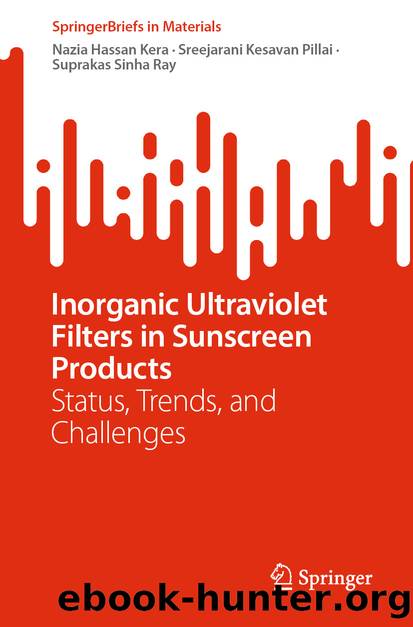Inorganic Ultraviolet Filters in Sunscreen Products by Nazia Hassan Kera & Sreejarani Kesavan Pillai & Suprakas Sinha Ray

Author:Nazia Hassan Kera & Sreejarani Kesavan Pillai & Suprakas Sinha Ray
Language: eng
Format: epub
ISBN: 9783031641145
Publisher: Springer Nature Switzerland
Blaise et al. [15] assessed the ecotoxicity of different metal oxide NPs by dispersing them in an aqueous solution and subjecting the filtrates obtained to a series of bioassays covering different taxonomic groups. The amount of TiO2 NPs retained in the filtrate, after filtration through a 0.22 µm membrane, was 54%, suggesting that NPs may be removed from water in the environment by partitioning on suspended solids and later form part of the sediment. TiO2 NPs were found to cause toxic effects to fish cells (trout primary hepatocyte) at 1â10 mg/L levels and were harmful to the invertebrate H. attenuate at 10â100 mg/L levels but did not exhibit toxicity to the invertebrate T. platyurus and the bacteria and phototrophic systems examined.
Microalgae, or phytoplankton, are primary producers that serve a vital role in aquatic environments [2â4]. Microalgae are abundant in fresh and marine water bodies and are relatively easy to culture and grow. Therefore, they are often used as model aquatic organisms in toxicity studies. Miller et al. [16] investigated the effect of ZnO and TiO2 NPs on the growth of four marine plankton species under low levels of UV light from cool white fluorescent lights. The growth rates of the different marine plankton species were significantly decreased by exposure to ZnO NPs but were not affected by TiO2 NPs, for NP concentrations of between 10 and 1000 µg/L. It was suggested that toxic effects were caused by free zinc ions assimilated by marine phytoplankton released from the dissolution of ZnO NPs. However, the effects of ZnO NPs could not be distinguished from those of the released zinc ions. Miller et al. [17] later found that TiO2 NPs exposed to low levels UVR, in simulated sunlight, caused toxic effects on marine plankton. The growth of marine phytoplankton was suppressed to varying extents for the different species studied and depended on the TiO2 concentrations used, which ranged from 1 to 7 mg/L. In the absence of UVR, the growth rates of different marine plankton species were typically not affected by exposure to TiO2 NPs, apart from I. galbana, when exposed to TiO2 at the highest concentration of 7 mg/L used in the study.
Suman et al. [18] found that the cell viability of the marine algae species, Chlorella vulgaris (C. vulgaris), decreased with increasing ZnO NP concentration and duration of exposure. ZnO NPs were found to induce significant oxidative stress in C. vulgaris cells. Oxidative stress was assessed by measuring the effect of ZnO NPs on the activity of different enzymes. The levels of superoxide dismutase (an enzymatic antioxidant) and reduced glutathione (a nonenzymatic antioxidant) were found to decrease with increasing ZnO NP dose, suggesting that enzyme activity was activated at low ZnO NP dose but inhibited at higher doses of ZnO NPs and indicating that ZnO NPs increased oxidative stress. The increasing lipid peroxidation levels with ZnO NP dose, further indicated oxidative stress due to ZnO NPs. The levels of LDH, which increased with ZnO NP dose and/or longer exposure durations, indicated cell membrane damage on exposure to ZnO NPs, which may cause cell death.
Download
This site does not store any files on its server. We only index and link to content provided by other sites. Please contact the content providers to delete copyright contents if any and email us, we'll remove relevant links or contents immediately.
| Automotive | Engineering |
| Transportation |
Whiskies Galore by Ian Buxton(41720)
Introduction to Aircraft Design (Cambridge Aerospace Series) by John P. Fielding(33017)
Small Unmanned Fixed-wing Aircraft Design by Andrew J. Keane Andras Sobester James P. Scanlan & András Sóbester & James P. Scanlan(32685)
Craft Beer for the Homebrewer by Michael Agnew(18082)
Turbulence by E. J. Noyes(7895)
The Complete Stick Figure Physics Tutorials by Allen Sarah(7265)
Kaplan MCAT General Chemistry Review by Kaplan(6823)
The Thirst by Nesbo Jo(6759)
Bad Blood by John Carreyrou(6477)
Modelling of Convective Heat and Mass Transfer in Rotating Flows by Igor V. Shevchuk(6354)
Learning SQL by Alan Beaulieu(6159)
Weapons of Math Destruction by Cathy O'Neil(6085)
Man-made Catastrophes and Risk Information Concealment by Dmitry Chernov & Didier Sornette(5878)
Digital Minimalism by Cal Newport;(5588)
Life 3.0: Being Human in the Age of Artificial Intelligence by Tegmark Max(5405)
iGen by Jean M. Twenge(5326)
Secrets of Antigravity Propulsion: Tesla, UFOs, and Classified Aerospace Technology by Ph.D. Paul A. Laviolette(5237)
Design of Trajectory Optimization Approach for Space Maneuver Vehicle Skip Entry Problems by Runqi Chai & Al Savvaris & Antonios Tsourdos & Senchun Chai(4957)
Electronic Devices & Circuits by Jacob Millman & Christos C. Halkias(4866)
